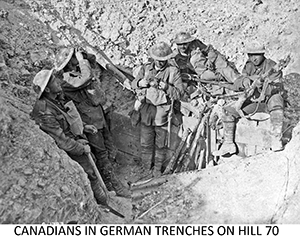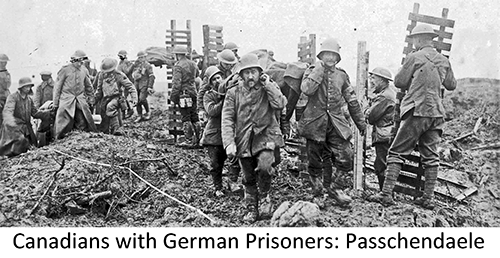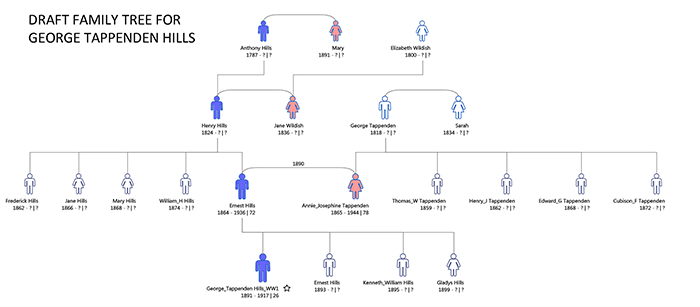First World War Project
George Tappenden HILLS (of Newnham)
b. 26th May 1891 Private, Service Number 116675 |

George was the first-born of grocer and draper Ernest and Annie Josephine Hills (née Tappenden), of Newnham, Kent. There is no obvious interpretation for George's decision to adopt his maternal family name - he was not christened with the middle name. Perhaps this was a conscious acknowledgement of the important esteem he held for his mother, who was also George's sole beneficiary. His younger brothers, Ernest and Kenneth William also served, leaving their sister Gladys at home. His father's business was based in Newnham Street, next to the George Inn. George's mother came from Hastingleigh (near Ashford), Kent.
In the 1911 Census, George is working at his father's shop as a Grocer's Assistant. Although born in Sandwich, he was baptised in Hastingleigh, where his recently married parents lived with Annie's parents. Sometime after 1911, George left for Canada, a pattern quite common across the Creekside Parishes (especially Teynham Parish). Curiously, his enlistment papers say his Canadian address was not given; nor have we found his emigration/immigration dates.
George's enlistment papers give us a more personal description. With a given age of 24 years, 7 months, he stood at 5 feet 10 inches, chest measurement 34½" to 37½" (expanded), black hair and dark brown eyes. He gave his occupation at Grocer.
| Faversham and North East Kent News of 15th December 1917 |
| Private George Hills, Canadian Forces, son of Mr. and Mrs. E. Hills, of Newnham, has been reported missing. He and his two brothers, Ernest and Kenneth, have been in France for more than a year. |
Thomas's records state that he was not eligible for posthumous award of the Star, Victory or British War Medals. This is a very curious fact for which we do not have an answer. His mother, Annie, was his sole beneficiary and received his other effects that included the soldier's plaque/scroll and balance of accounts.
Military Experience of George Tappenden Hills
George enlisted as a "Trooper" in the 11th Canadian Mounted Rifles (C.M.R.) on 4th January 1916, confirmed on 9th January at Victoria, British Columbia where he also passed his medical two days later (11th) at "Willows Camp". He then received a period of training before, on 8th July, he embarked the SS "Lapland" at Halifax, Nova Scotia, and landed in England on 25th July 1916.
Still part of the 11/C.M.R., George was at Shornecliffe when, on 13th October 1916, he was drafted into the 29th Battalion, Canadian Expeditionary Force at Cheriton Camp. This decision was confirmed by the O.C. 29th Battalion to move off to the Canadian Base Depot, France. On 4th November, George departed for the Field to join the 29th Battalion, which he reached on 7th November. Only one week later (14th November), George found himself in No.5 Field Ambulance suffering from influenza from which he finally returned to his unit on 19th November. From this date, George can be said to be fully exposed to fighting in the Field. The only other event 'out of the ordinary' on George's record was a period of "stoppages" to cover the cost of repair to damaged Government property namely, on 23rd January 1917, 1 cut Greatcoat, value 4 shillings.
From November to the end of January 1917, the War Diary reveals that George was in and out of trenches at SOUCHEZ and LORETTE SPUR DEFENCES. This was a period of relative calm when drafts of new men arrived and several working parties and patrols provided.
This then brings us up to the period from 29th January 1917 when the Battalion moved from billets at BAJUS to RAIMBERT, MAISNIL LES RUITE, ESTREE CAUCHIE, MOUNT ST. ELOY for training. Then into Support Trenches in the ECURIE sub-sector before moving back to MAISNIL BOUCHE on 8th March. In and out for Brigade training combined with spells in Support Trenches.
It was in April that the Battalion readied itself for a very significant battle for the Canadian Corps - the Attack on Vimy Ridge. On 8th April, the Battalion went to ASSINIBOINE and Assembly Area. The next day they moved beyond the LENS-ARRAS Road to BOIS DE LA VILLE and the attack on the German strong-position on Vimy Ridge above Ypres. On 11th April, the Battalion was in ZIVY CAVE before they went back into Reserve the next day and in and out of Reserve and Divisional Support.
 On 3rd May, the 1st and 2nd Canadian Divisions attacked and succeeded in capturing FRESNOY. Following this series of engagements, the Battalion was a period of cleaning up and reorganizing between 8th and 14th May in the Divisional Support Area, East of NEUVILLE ST. VAAST. June was spent in quietly in training. Between 4th July and 26th July, the Battalion moving in and out of Front Line, Brigade Reserve, and Divisional Reserve. Between 26th July and 4th August, George and his comrades were equipping in Divisional Reserve (MAROC) for an attack. Between 9th August to 22nd August the Battalion was active in the Capture of HILL 70.
On 3rd May, the 1st and 2nd Canadian Divisions attacked and succeeded in capturing FRESNOY. Following this series of engagements, the Battalion was a period of cleaning up and reorganizing between 8th and 14th May in the Divisional Support Area, East of NEUVILLE ST. VAAST. June was spent in quietly in training. Between 4th July and 26th July, the Battalion moving in and out of Front Line, Brigade Reserve, and Divisional Reserve. Between 26th July and 4th August, George and his comrades were equipping in Divisional Reserve (MAROC) for an attack. Between 9th August to 22nd August the Battalion was active in the Capture of HILL 70.
September and October were relatively quiet, in and out of trenches.
We pick up the War Diary again from 31st October - "Cold but generally fine. Company parades in the forenoon. Two buses of Officers and men proceeded to POPERHINGE to see model of country in PASSCHENDAELE area.
1st November: HONDENGHEM AREA: Weather cold and generally fine. Training by Platoons in the attack carried out during the morning.
2nd November: HONDENGHEM AREA: Fine and cloudy. Training by Companies in the morning. In the afternoon the Battalion prepared to move early on the morning of the 3rd. Major W.N. Maclean and Lieut F.W. Melsom returned from leave.
3rd November: HONDENGHEM AREA: Fine and clear. The Battalion marched to CAESTER from HONDINGHEM at 7.20 a.m. and entrained at 8.45 a.m., journeyed to YPRES by train in an hour and twenty-five minutes. After detraining, marched to bivouac area one mile east of YPRES. Transport moved by road and arrived at the new camp at about 5 p.m.

4th November: POTIJZE and FRONT LINE: Fine and clear. The Battalion, less "B" Company, moved into the line in front of PASSCHENDAELE and relieved the 21st Canadian Battalion. The relief was carried out successfully, and the outposts established by the 21st were taken over to protect the assembly area. Two new post were pushed out and the line consolidated effectively, and organized in preparation for the operation on the 6th.
One officer and 50 O.R. carried lumber from Brigade Headquarters, ZONNEBEKE Road, to railway embankment near ZONNEBEKE Station.
5th November: POTIJZE and FRONT LINE: Fine.
The enemy shelled the area heavily from 4.50 a.m. to 5.50 a.m., especially the front line.
At 11.40 Private McComber, C., No. 414884, of "C" Company, brought down a hostile aeroplane, which fell just inside the enemy lines. During the day the enemy shelling was not severe. Guides we sent out early in the afternoon to guide in 27th, 28th and 31st Battalions. Those were casualties. "B" Company moved from POTIJZE Area to ABRAHAM HEIGHTS.
The casualties caused by shelling early in the day were: Killed, 4 O.R. Wounded, 4 O.R. Captain J.C. Bridgman and Captain H.F. Preston returned from leave. Captain A.B. Watson returned to duty from 1st Army School.
6th November: FRONT LINE: Weather generally fine; showery during morning.
See Summary of Operations for this date. Evacuation party of 100 O.R. supplied to A.D.S. Both Casualties: Other Ranks: Killed, 21, Wounded, 79. Missing, 8. Bands and most cooks called on [to replenish losses]. Lieutenant A.G. Graham returned from leave.
7th November: POTIJZE: Rain, and very stormy.
The Battalion moved back to POTIJZE Area on the night of 6th/7th except "B" Company, and rested all day. "B" Company remained in Support at ABRAHAM HEIGHTS.
Casualties: Lieut A.J. Harvey wounded. Other Ranks, 19 wounded.
8th November: POTIJZE: Weather, fine morning; wet afternoon and evening.
"B" Company joined the Battalion early in the morning at POTIJZE. During the morning the Battalion marched from the bivouac camp in POTIJZE Area to YPRES and entrained for BRANKHOEK.
After detraining, marched to TORONTO Camp.
Casualties: Wounded, 2 O.R. Caused by enemy aeroplane dropping 5 bombs beside the camp at 4 a.m.
9th November: BRANDHOEK. TORONTO CAMP: Fine and stormy.
Remained at TORONTO Camp all day. Companies carried out inspections and re-equipped as far as possible articles lost in action.
Special Brigade Order issued by Brigadier-General H.B.D. Ketchen.
Circumstances of the death of William McGarry
When George died, he was reported as "missing" initially before being classified as killed "on or since" 6th November 1917. This was later confirmed as his date of death.
After his death, Thomas was buried at Sheet 28, N.E. D.5.b.8.6., later identified by his disc and exhumed for burial at the Passchendaele New British Cemetery. His gravestone had the added inscription "DUTY CALLED, HE ANSWERED" - paid for by his mother, Mrs A.J. Hills, Newnham, Kent.
The events of 6th November are contained in a report attached to the War Diary as "Appendix 3".
29th Canadian Battalion. British Columbian Regiment.
Summary of Operations from 4th to 7th November in Passchendaele Area.
On the night of November 4/5th the 29th Battalion moved from POTIJZE and took over the frontage from the 21st Battalion upon which the attack was to be made on PASSCHENDAELE by the 6th Brigade.
The 29th Battalion commenced moving from POTIJZE at 2 p.m. on the 6th and the relief was affected satisfactorily at 10.15 p.m. The 21st Battalion then proceeded out but it was found that the 4th Brigade had ordered two outposts to be established to the relief was held over until a later hour and a party of the 21st Battalion returned to do this. Our covering parties rendered them all assistance possible and then manned the posts which were established.
Disposition of the 29th Battalion was then:- Front line "A" Company on the left, "D" Company on the right, "C" Company in support about 800 yards behind the jumping off line. "B" Company in POTIJZE.
As soon as the relief was completed a systematic consolidation of the jumping off line was affected, and an additional post to the four posts established by the 21st Battalion was established. Then all posts were pushed forward to within varying distances of from 30 to 50 yards of the enemy posts, and manned with Lewis Guns and rifles. Considerable rifle and Machine Gun fire was experienced during this time but the posts were finally established and consolidation affected about 5 a.m. on the morning of the 5th. This rendered protection to the area complete and permitted the assembly of the Brigade to be carried out successfully without being discovered by the enemy. Those posts were held until the assembly was complete.
The work of laying out the Assembly area was carried out systematically, frontage was allotted to each Battalion:- 27th Battalion right, 31st Battalion centre, 28th Battalion left.
All ranks worked thoroughly and the area was divided out to the satisfaction of the assembling Battalions.
The work was rendered difficult on account of no knowledge of the front and the small area upon which such a large number of men had to be assembled.
Captain McSpadden did valuable work in this connection and the area was all ready for the assembly at 5 p.m. on the afternoon of the 5th. The area was allotted so that each Company could come in and take up its ground without any confusion or interference with each other. Heavy shelling on the whole area on the morning of the 5/6th caused a number of casualties and rendered it difficult to carry on the work.
The day of the 5th was comparatively quiet and fine. Enemy aircraft were active and many low flying hostile planes approached our lines. At 11.45 a.m. Private McComber of "C" Company shot down a hostile plane with Lewis Gun fire and it was seen to crash just inside the enemy's lines opposite the 6th Brigade front. This plane was sweeping our position with Machine gun fire at the time. All during the day firing was kept up upon low flying craft and much of it was discouraged for the remainder of the day.
Arrangement of Guides.- The arrangements for guides were made for each Battalion – 10 guides being provided for each. Those were provided from "C" Company, the Support Company. Lieut. Meredith took charge of the guides and proceeded to ABRAHAM HEIGHTS where the incoming Battalions were met in the following order.- 31st, 27th, 28th. Those were all guided in successfully from this point to the position of the support Company were each Battalion was taken in charge by guides from the front line Companies, "A" and "D" Companies under the direction of Captain Hepworth, and from there taken to their assembly area. As each Company arrived forward it was taken in charge and led to its area under the directions of Major Maclean, M.C., and Captain McSpadden.
The assembly was completed without mishap at about 1 p.m. and without a casualty as far as is known between ABRAHAM HEIGHTS and the Assembly Area.
When the assembly was completed the 29th Battalion moved to its own Assembly area in support and reserve. "A" and "D" Companies in support just behind DEADWOOD FARM 800 yards in rear of jumping off line, "C" Company moved back to ABRAHAM HEIGHTS and "B" Company moved up from POTIJZE to ABRAHAM HEIGHTS. One Platoon of "D" Company remained at CREST FARM 100 yards in rear of jumping off line as garrison to 3 Machine Guns, the intention being that this place was to be a strong point. Our assembly being completed at 2 a.m.
At about 4 a.m. on the morning of the 6th, enemy commenced shelling the front line and support area heavily causing some casualties. Shelling kept up well along towards zero hour which was at 6 a.m. At this hour the attack commenced and the Brigade went forward and captured their objectives without any halt.
At about 7.30, prisoners commenced coming in carrying wounded, this continued all day. At about 10 a.m. the enemy commenced a terrific fire on support Companies which suffered heavily in consequence – "A" Company suffered 60 Casualties, "D" Company 25 in this area during the course of the day.
At 2 p.m. orders were received from Brigade for one Company to retire to ABRAHAM HEIGHTS. "D" Company went out carrying with it as many wounded as the Company could carry and reached ABRAHAM HEIGHTS at about 4 p.m. "A" Company remained in position during the remainder of the day until orders were received that it could withdraw.
At an early hour word was received that the 26th Battalion needed 2 Lewis Guns, those were immediately sent forward with their gun crews and reinforced that 28th Battalion, where they remained until the 28th came out.
At 10 p.m. a party was sent up under Lieut. Roade of "A" Company and carried 20,000 rounds of S.A.A. to the 31st Battalion in the front line. This party suffered 12 casualties (6 killed and 6 wounded) on this trip. The ammunition was delivered and the party returned to its own position.
Word was received at 11 p.m. on the 6th that the Battalion less "B" Company and the platoon of "D" Company at CREST FARM would withdraw to POTIJZE. This was done and "B" Company remained in position at ABRAHAM HEIGHTS until the Brigade was relieved, and one platoon of "D" Company at CREST FARM remained there until 3 a.m. on the morning of the 8th when it returned to POTIJZE after the 5th Brigade had taken over the line.
Action of Reserve Company. "B" Company at ABRAHAM HEIGHTS was used carrying rations and ammunition to the front line. Considering the length of time that carrying parties were out, the number of casualties was small, - only 10 being experienced during the action. This Company withdrew to POTIJZE on the relief of the Brigade.
Enemy Shelling. The shell fire experienced in the positions held by "A" and "D" Companies in support, and the area around Battalion Headquarters at HEINE HOUSE is considered to be the worst that this Battalion has ever experienced and it is suggested that this area be taken into consideration and as far as possible troops being kept out of it, as the greater number of the casualties experienced were caused there within a few hours.
The Pill Box in which Battalion Headquarters was established proved to be a death trap – many casualties to Runners and Observers being caused around this particular place.
Lt. Col.
Commanding,
29th Canadian Battalion.
British Columbia Regiment.
APPENDIX TO SUMMARY OF OPERATIONS IN FRONT OF PASSCHENDAELE, NOVEMBER 4th/7th, 1917. |
||||
| Total Strength of the Battalion going into action, November 4th, 1917. | Officers | Other Ranks | ||
| 23 | 577 | |||
| CASUALTIES for the Tour: | ||||
| Officers | Other Ranks | |||
| Killed | 0 | 25 | ||
| Wounded | 1 | 104 | ||
| Missing | 0 | 8 | 1 | 137 |
Remaining strength |
22 | 440 | ||


 World War 1 Pages
World War 1 Pages